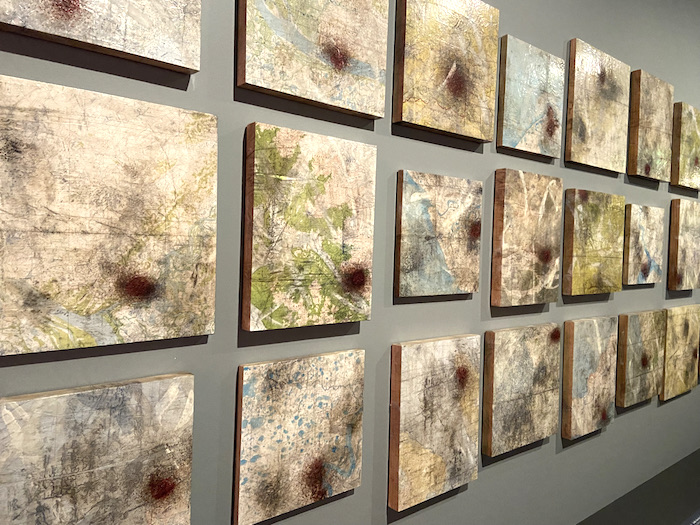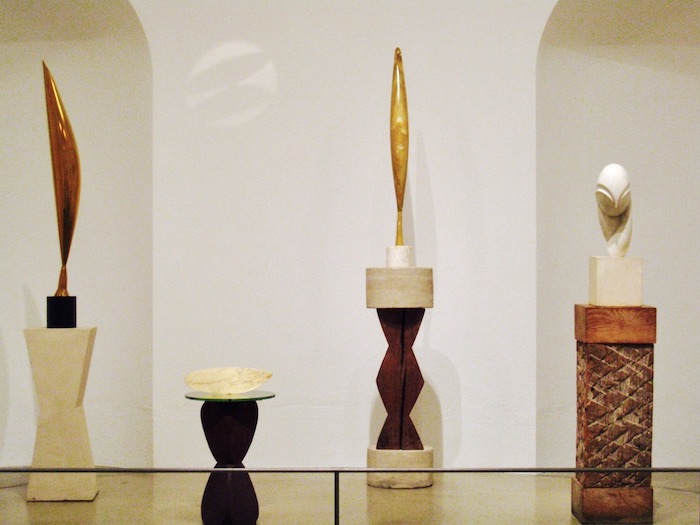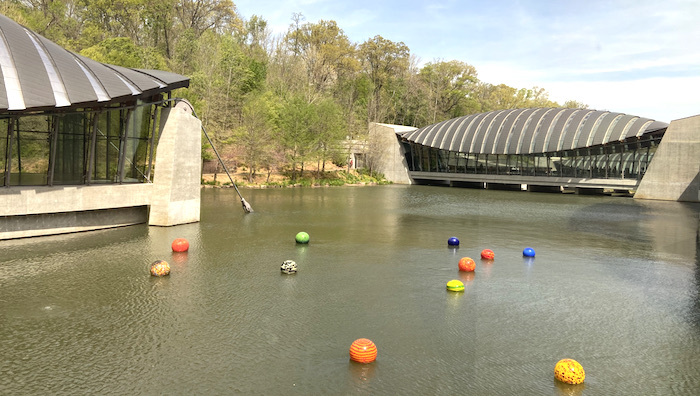It’s difficult to curate a show of your own work—to separate your complex feelings following the creative process. It might be helpful to think about your art like a museum thinks about its collections.
And I’m not talking about exhibitions here. I’m talking about how you’re showing the work on your website.

Think Like a Museum Curator
In a separate post I discussed the value of curating your art and approaching it as an additive rather than subtractive process.
I wrote:
The first step in curating your art is to start with a piece or two that best represent what you’re trying to communicate. After you’ve done this, you can build your exhibition or Web page around that piece.
If you find you have too many in the end, you can start subtracting.
That’s how I hope you view your website. Start with the strongest work and add only additional work when it makes the collection stronger. If you’re honest with yourself, you know that some of the work won’t stand up.
The Magic Number of Pieces to Show
The question that prompted this article was from a reader who wondered whether or not there is a sweet spot for the amount of inventory visible to viewers, collectors, gallerists and curators. There is no such sweet spot that would satisfy all of these groups of people, but I’ll take a stab at an answer.

I have found that 12-15 images per website page is a good number, but impact trumps any formula.
Impact, above all else, is what you’re after. If you want people to say “WOW!” consider the following.
- What are you trying to communicate?
- What number, what piece, what grouping best communicates your idea?
- Why should you include that work? Why is it important? What does it contribute to the works you’ve already selected?
- What should you leave out? What has already sold? What doesn’t belong? What should you rethink/rework?
And … You can’t make an impact online with tiny images. Thumbnails should take up most of the width of a visible page. In I’d Rather Be in the Studio, I suggest thumbnails no smaller than 150 pixels wide, but 200-250 would be even better. In other words, thumbnails that are as big as possible.
After you have lived with the work for awhile, you might feel the need to mix things up. Again, we can go back to how curators work in museums.

Dale Chihuly’s floating glass orbs, Niijima Floats at Crystal Bridges Museum of American Art.
Mix It Up
Museums have permanent collections that they own. The works are always in their possession, whether they’re on the wall or in storage. If the art stayed in the same place all of the time, the museum risks its role as a dynamic force in the interpretation of culture.
Museums must frequently present art in new contexts. Times change, new curators with their own viewpoints come on staff, and additional objects are added to the collections.
Fresh installations of the art stave off visitor boredom. People look at the work differently and are less likely to dismiss the art with the statement “I’ve already seen that.”
Museums do this through exhibitions. You can do the same in a brick-and-mortar space, or do it through virtual exhibitions on your website, in your newsletter, in carefully crafted blog posts, in album groupings on Facebook, or on Pinterest boards.
The bottom line is that I encourage you to approach the curatorial process like you’re making a piece of art because you are. You are creating a composition from separate parts that might have different meaning when discovered in new combinations.
Want more examples for remixing your work? Read this post.
This post was first published on August 21, 2013 and has been updated with original comments intact.



18 thoughts on “Curating the Art on Your Artist Website”
Brilliant!! Oh, Alyson, this is perfectly well-timed. (Smacks self on forehead) why didn’t I think if this before? I love it. Will use this for sure. I am just learning how to start at the end – what is my message? Finally, all the lessons are coming together.
I’m so happy it spurred some ideas, Amantha.
Some of the competing issues are…looking like a more curated show vs using the Website as a kind of “store”, where the viewer can look for a possicle purchase. And showing some red dots to indicate things are selling. Again, I eagerly await your specific suggestions. Thanks, Alyson.
You’ve often said it well – artists make for the worst curators of their own work. Getting to know a curator whose practice and focus is along the same lines as yours is a valuable experience. You could definitely think of hiring someone you respect to help you curate – I’m working on that, as I often find my own body of work with many arms and legs, sometimes looking like a bit of a scrambled egg. I’m grateful during a gallery show for an expert and new set of eyes helping me to redefine the thread of my work.
Janice: Excellent point. It’s so helpful to bring others into the process. You will learn a lot.
Am so enjoying this series of posts, Alyson. Curation is a nice juicy concept and you’re exactly the right person to explain it.
Happy to hear it, Cherry. Thanks for being here.
I love this series on Curating. Alyson, the link on fresh installations featured the Bruce Price works on paper. How are those works attached to the museum wall? Often I show my works on paper unframed using a system with small magnets. I am curious how the DAM does…
Kathleen: I plan on seeing the show this Friday and will let you know. Some look like they have sleeves – easier to do with textiles than with paper. I still think you should be showing your work framed. 😉
I did a curatorial workshop last two years ago, in order understand the way think the profesional curators and to do well out for my work too.
The fact, It is no easy thing curated your own work.
But in change, now I have a good overview point about what can work and what not. Also about how put order in the work you want to show.
I try to put in practice that knowledge when, for exemple when I make an exhibition for me, or developed my website, and in a best way of course, when I work as curator for others artist friends.
A interesting point I have in mind when working on my work (on website or in a real place) have clear that ¨no matter what do you doing, you never please everyone¨ That statement could sound comun and logical, but we can forget easily when is about you and your work.
Just search what your rocking point for and focus on it. Work out. That means, selected a matter you will focus and developed in this way. You can have other oportunities to change to build other points. Just try to point not in a lot of matters.
Of course, its easy to say but not easy to work out.
Excuseme if not well to understand. English it is not my first tongue.
Thank you so much for this series of curatorial articules.
Roxanna: Your English is beautiful.
A curatorial workshop would be an excellent experience for any artist. Where did you do this?
I done the workshop in Santo Domingo, with the support to Centro Cultural de España and Centro Leon along with five expert curators and a writter. Two former directors of Art Modern Musseum both in Santo Domingo and Costa Rica, museology, speach with art critics, a special talk from an Argentina´s curator, Aditionaly the curatorial individuals and groups from Cuba, Puerto Rico and Dominican Rep.
It was three amazing months!, I really enjoy it and found this experience essential and necessary as artist . My firsts exhibitions have nothing to do in reference, with the ones after that.
😀
If you wanna have a huge exhibition, could be better have a curator rather than curate yourself. You can built something really great together and learn a lot for futures. Of course you´ll be confortable with the final result.
Anyway, not matter if you have a curator or curate for yourself, if you have knowledges of curatorial matters could give you self confidence in why you do what you do.
This is of great help. I am working on a set of paintings and drawings with a theme of “hope”. It would really be hard for me to curate my work since I am starting up working on improving my artwork and composition. But knowing the basics and understanding how curators look, it gives me an idea on how I can at least work on an art that are closely related to tell a story.
I am learning a lot from your e-mails and blogs. Thanks Ms. Stanfield.
I find it best to allow someone else – more objective friend or relative – to select best works to show. This not only takes my bias out of the loop, but also gives me a more accurate understanding of what the public looks for.
Pingback: 5 Cures for the Email Blahs « Art Biz Blog
Thank you Alyson. This is very timely as I just updated my website. What to include was difficult and your guidelines help give clarity.
Adrienne: I’m so happy you found this helpful. And glad I updated it recently!